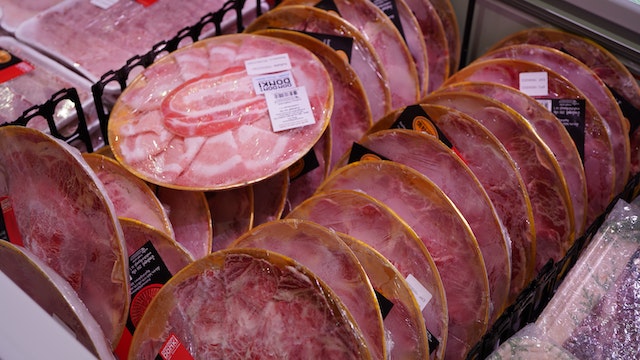
How are foods frozen? They are dipped in something cold, pressed between cold plates, or exposed to cold air.
Once vegetables or fruits are picked, or once meat is butchered, they have to be frozen as quickly as possible. The second these foods are exposed to the air, they start to break down. The faster they can be frozen, the better they will be preserved. Before foods can be frozen, they have to be prepared. There are two general ways of doing this. The first way is blanching with steam or hot water. Vegetables and meat are usually steamed. When vegetables are picked, enzymes start to go to work to decompose them. Blanching switches these enzymes off. With meat, blanching kills any bacteria that might be on the surface of the meat. Fruits are usually dipped in ascorbic acid or a sugar solution to stop them going brown.
Once they have been prepared, they need to be frozen very quickly. There are three main methods of freezing, but all of them are very fast. If a food is frozen quickly, a lot of small ice crystals form inside the food. If the food is frozen slowly, the way you would in your freezer at home, fewer, but much larger ice crystals can form, which rupture the cell walls and leave the food mushy when it is thawed. Lager ice crystals can also make the food go brown while it is frozen.
The first way to freeze food quickly is by using contact freezing. This method was developed by Birdseye in the 1920s. Food is placed in its packaging on shelves that have refrigerant running through them. When the machine is switched on, a top shelf comes down and lightly presses the food against the bottom shelf. This slight pressure ensures that the food is constantly in contact with the cold shelves and it freezes quickly. The pressure is maintained as the food expands. This method is used for packaged, or fairly small items and bags of food. Contact freezing is the way that freshly picked fruit and vegetables are frozen, except it is carried out on a chilled conveyor belt and not with shelves.
The second way to quickly freeze something is with super-chilled air or gas. This is the oldest method of freezing and is the cheapest and most simple. It is used for anything, but especially for larger items such as carcasses. The item to be frozen is hung or placed in the freezer. Air cooled down to between -35 ˚C and -52 ˚C is blown around the food. Large fans are used to increase the amount of heat that is lost through the surface of the food. This works because the fans blow the cold air across the surface of the food, increasing its velocity and removing more heat more quickly. This is called forced convection. The problem with this type of freezing is it requires a lot of power and the air becomes very dry, which can suck moisture out of unwrapped food.
The third way is to dip the food being frozen in liquid nitrogen, carbon dioxide, or halocarbon. This is far too expensive for large scale commercial freezing and is only used in small operations. However, recently, cryogenic freezing has been increasing. This uses the same chemicals, but they are sprayed over the foods to be frozen in the form of a super-cooled liquefied gas solution. The gas is -195 ˚C and the food freezes almost instantly. This low temperature is too to keep, so the food is warmed back up to -30 ˚C and it is stored at that temperature.
There are other methods of freezing food, but these are the main ones. Once the food is frozen, the company aims to get it to the shop and sold as quickly as possible, although frozen food will last indefinitely. Bacteria cannot grow at freezer temperatures and the food will always be safe to eat. That doesn’t mean that the food will taste good, though. The longer something is frozen, the less tasty it will be when defrosted. Most things are meant to be frozen for a few weeks to a few months before being eaten. Things frozen for a long time start to get freezer burn, which is where the food oxidizes and dehydrates. Unless the food is sealed in a completely airtight container, which is impossible, air is going to get to the food. Once that happens, water will be pulled out of the food into the atmosphere. The color of the food will change as well. When you defrost the food, it will still be edible, but it will be very dry and tasteless. And that is what I learned today.
Sources
https://www.sciencedirect.com/science/article/abs/pii/S1359431111007101
http://www.foodreference.com/html/a-commercial-freezing-1208.html
https://en.wikipedia.org/wiki/Halocarbon
https://extension.umn.edu/preserving-and-preparing/science-freezing-foods
https://en.wikipedia.org/wiki/Frozen_food
https://ask.usda.gov/s/article/How-long-can-you-freeze-beef
https://www.highspeedtraining.co.uk/hub/how-long-can-you-store-frozen-food-for/
https://en.wikipedia.org/wiki/Freezer_burn
